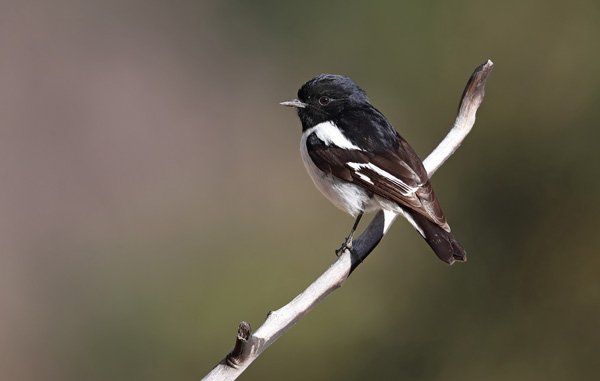By Ian Davidson and Chris Tzaros – Wangaratta Landcare & Sustainability
Quite a few species of birds occurring throughout the north-east region feature conspicuous black and white plumage. This includes many common and familiar species such as the Willie Wagtail, Magpie-lark and of course the Australian Magpie, but one black and white species that is considerably rarer and less well known is the Hooded Robin.
Though the Hooded Robin might lack the bright colours of some of our other ‘red’ robins, males are rather boldly marked with a jet-black hood, back and wings.
As is the case with many other woodland birds in south-eastern Australia, the population of the Hooded Robin has declined significantly in recent decades. Although there are many places in this region where the species can be encountered, it has all but disappeared from many other parts of its range where it was once more common. Hooded Robins have special needs in that they require larger patches of remnant open woodland habitat that are well-connected, and as a ground-feeding species they rely on a healthy and complex layer of leaf-litter, scattered fallen timber, patches of open ground and perennial native grasses and small shrubs. They also benefit from having patches of saplings and larger shrubs, which they use for shelter and nesting. The conversion of native woodlands into open farming country right across vast areas of the Hooded Robins range is responsible for their decline, and there is currently much concern over the species’ ongoing existence in many rural landscapes. As such, it is listed as a threatened species in both Victoria and New South Wales.
Locally, Hooded Robins can be seen around the Warby Ranges and Eldorado hills. They especially favour the more open woodland edges of larger forest areas. As with all robins, Hooded Robins are rather quiet and shy. They perch on low, exposed sites such as fallen branches, searching the ground nearby for prey, from which they pounce onto. Food consists largely of spiders, beetles, grubs, worms, moths and various insects, which are typically gleaned from the ground but taken back to a low perch to be consumed. They call infrequently throughout much of the year, but during the breeding season, males in particular sing to advertise to females and to maintain a breeding territory. Their calls are often heard around dawn and they sometimes call during moonlit nights.

